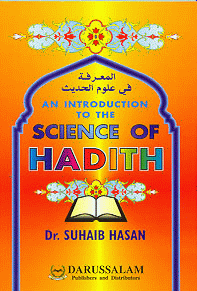THE CLASSIFICATION OF HADITH: According to the reliability and memory of the reporters
The final verdict on a hadith, i.e. sahih (sound), hasan (good), da'if (weak) or maudu' (fabricated, forged), depends critically on this factor.
Among the early traditionists, mostly of the first two centuries, ahadith were classified into two categories only: sahih and da'if; al- Tirmidhi was to be the first to distinguish hasan from da'if. This is why traditionists and jurists such as Ahmad, who seemed to argue on the basis of da'if ahadith sometimes, were in fact basing their argument on the ahadith which were later to be known as hasan. 65
We now examine in more detail these four important classes of ahadith.
Sahih
Al-Shafi'i states the following requirement in order for a hadith which is not mutawatir to be acceptable:
"Each reporter should be trustworthy in his religion; he should be known to be truthful in his narrating, to understand what he narrates, to know how a different expression can alter the meaning, and report the wording of the hadith verbatim, not only its meaning. This is because if he does not know how a different expression can change the whole meaning, he will not know if he has changed what is lawful into what is prohibited. Hence, if he reports the hadith according to its wording, no change of meaning will be found at all. Moreover, he should be a good memoriser if he happens to report from his memory, or a good preserver of his writings if he happens to report from them. He should agree with the narrations of the huffaz (leading authorities in Hadith), if he reports something which they do also. He should not be a mudallis, who narrates from someone he met something he did not hear, nor should he report from the Prophet (may Allah bless him and grant him peace) contrary to what reliable sources have reported from him. In addition, the one who is above him (in the isnad) should be of the same quality, [and so on,] until the hadith goes back uninterrupted to the Prophet (may Allah bless him and grant him peace) or any authority below him." 66
Ibn al-Salah, however, defines a sahih hadith more precisely by saying:
"A sahih hadith is the one which has a continuous isnad, made up of reporters of trustworthy memory from similar authorities, and which is found to be free from any irregularities (i.e. in the text) or defects (i.e. in the isnad)."
By the above definition, no room is left for any weak hadith, whether, for example, it is munqati', mu'dal, mudtarib, maqlub, shadhdh, munkar, ma'lul, or contains a mudallis. The definition also excludes hasan ahadith, as will be discussed under that heading.
Of all the collectors of hadith, al-Bukhari and Muslim were greatly admired because of their tireless attempts to collect sahih ahadith only. It is generally understood that the more trustworthy and of good memory the reporters, the more authentic the hadith. The isnad: al- Shafi'i --- Malik --- Nafi' --- 'Abdullah b. 'Umar --- The Prophet (may Allah bless him and grant him peace), is called a "golden isnad" because of its renowned reporters. 67
Some traditionists prefer Sahih al-Bukhari to Sahih Muslim because al-Bukhari always looked for those reporters who had either accompanied or met each other, even if only once in their lifetime. On the other hand, Muslim would accept a reporter who is simply found to be contemporary to his immediate authority in reporting. 68
The following grading is given for sahih ahadith only:
- those which are transmitted by both al- Bukhari and Muslim;
- those which are transmitted by al-Bukhari only;
- those which are transmitted by Muslim only;those which are not found in the above two collections, but
- which agree with the requirements of both al-Bukhari and Muslim;
- which agree with the requirements of al- Bukhari only;
- which agree with the requirements of Muslim only; and
- those declared sahih by other traditionists. 69
Hasan
Al-Tirmidhi means by hadith hasan: a hadith which is not shadhdh, nor contains a disparaged reporter in its isnad, and which is reported through more than one route of narration. 70
Al-Khattabi (d. 388) states a very concise definition, "It is the one where its source is known and its reporters are unambiguous."
By this he means that the reporters of the hadith should not be of a doubtful nature, such as with the mursal or munqati' hadith, or one containing a mudallis.
Ibn al-Salah classifies hasan into two categories:
- one with an isnad containing a reporter who is mastur ("screened", i.e. no prominent person reported from him) but is not totally careless in his reporting, provided that a similar text is reported through another isnad as well;
- one with an isnad containing a reporter who is known to be truthful and reliable, but is a degree less in his preservation/memory of hadith in comparison to the reporters of sahih ahadith.
In both categories, Ibn al-Salah requires that the hadith be free of any shudhudh (irregularities). 71
Al-Dhahabi, after giving the various definitions, says, "A hasan hadith is one which excels the da'if but nevertheless does not reach the standard of a sahih hadith."72 In the light of this definition, the following isnads are hasan according to al-Dhahabi:
- Bahz b. Hakam --- his father --- his grandfather;
- 'Amr b. Shu'aib --- his father --- his grandfather;
- Muhammad b. 'Amr --- Abu Salamah --- Abu Hurairah.
Reporters such as al-Harith b. 'Abdullah, 'Asim b. Damurah, Hajjaj b. Artat, Khusaif b. 'Abd al- Rahman and Darraj Abu al-Samh attract different verdicts: some traditionists declare their ahadith hasan, others declare them da'if. 73
Example of a hasan hadith
Malik, Abu Dawud, al-Tirmidhi and al-Hakim reported through their isnads from 'Amr b. Shu'aib --- his father --- his grandfather, that the Messenger of Allah (may Allah bless him and grant him peace) said,
"A single rider is a devil (i.e. disobedient), two riders are two devils, but three makes a travelling party."
Al-Tirmidhi declares this hadith to be hasan because of the above isnad, which falls short of the requirements for a sahih hadith. 74
Several weak ahadith may mutually support each other to the level of hasan
According to the definitions of al-Tirmidhi and Ibn al-Salah, a number of similar weak ahadith on a particular issue can be raised to the degree of hasan if the weakness found in their reporters is of a mild nature. Such a hadith is known as hasan li ghairihi (hasan due to others), to distinguish it from the type previously-discussed, which is hasan li dhatihi (hasan in itself). Similarly, several hasan ahadith on the same subject may make the hadith sahih li ghairihi, to be distinguished from the previously-discussed sahih li dhatihi.
However, in case the weakness is severe (e.g., the reporter is accused of lying or the hadith is itself shadhdh), such very weak ahadith will not support each other and will remain weak. For example, the well-known hadith, "He who preserves forty ahadith for my Ummah will be raised by Allah on the Day of Resurrection among the men of understanding", has been declared to be da'if by most of the traditionists, although it is reported through several routes. 75
Da'if
A hadith which fails to reach the status of hasan is da'if. Usually, the weakness is one of discontinuity in the isnad, in which case the hadith could be mursal, mu'allaq, mudallas, munqati' or mu'dal, according to the precise nature of the discontinuity, or one of a reporter having a disparaged character, such as due to his telling lies, excessive mistakes, opposition to the narration of more reliable sources, involvement in innovation, or ambiguity surrounding his person.
The smaller the number and importance of defects, the less severe the weakness. The more the defects in number and severity, the closer the hadith will be to being maudu' (fabricated). 76
Some ahadith, according to the variation in the nature of the weakness associated with its reporters, rank at the bottom of the hasan grade or at the top of the da'if grade. Reporters such as 'Abdullah b. Lahi'ah (a famous judge from Egypt), 'Abd al-Rahman b. Zaid b. Aslam, Abu Bakr b. Abi Maryam al-Himsi, Faraj b. Fadalah, and Rishdin b. Sa'd attract such types of varying ranks as they are neither extremely good preservers nor totally abandoned by the traditionists. 77
Maudu'
Al-Dhahabi defines maudu' (fabricated, forged) as the term applied to a hadith, the text of which goes against the established norms of the Prophet's sayings (may Allah bless him and grant him peace), or its reporters include a liar, e.g. the forty ahadith known as Wad'aniyyah or the small collection of ahadith which was fabricated and claimed to have been reported by 'Ali al-Rida, the eighth Imam of the Ithna 'Ashari Shi'ah. 78
A number of traditionists have collected fabricated ahadith separately in order to distinguish them from other ahadith; among them are Ibn al-Jauzi in al-Maudu'at, al-Jauzaqani in Kitab al-Abatil, al-Suyuti in al-La'ali al- Masnu'ah fi 'l-Ahadith al-Maudu'ah, and 'Ali al- Qari in al-Maudu'at.
Some of these ahadith were known to be spurious by the confession of their inventors. For example, Muhammad b. Sa'id al-Maslub used to say, "It is not wrong to fabricate an isnad for a sound statement." 79 Another notorious inventor, 'Abd al-Karim Abu 'l-Auja, who was killed and crucified by Muhammad b. Sulaiman b. 'Ali, governor of Basrah, admitted that he had fabricated four thousand ahadith declaring lawful the prohibited and vice-versa. 80
Maudu' ahadith are also recognised by external evidence related to a discrepancy found in the dates or times of a particular incident. 81 For example, when the second caliph, 'Umar b. al- Khattab decided to expel the Jews from Khaibar, some Jewish dignitaries brought a document to 'Umar apparently proving that the Prophet (may Allah bless him and grant him peace) had intended that they stay there by exempting them from the jizyah (tax on non-Muslims under the rule of Muslims); the document carried the witness of two Companions, Sa'd b. Mu'adh and Mu'awiyah b. Abi Sufyan. 'Umar rejected the document outright, knowing that it was fabricated because the conquest of Khaibar took place in 6 AH, whereas Sa'd b. Mu'adh died in 3 AH just after the Battle of the Trench, and Mu'awiyah embraced Islam in 8 AH, after the conquest of Makkah! 82
The author, in his Criticism of Hadith among Muslims with reference to Sunan Ibn Majah, has given more examples of fabricated ahadith under the following eight categories of causes of fabrication: 83
- political differences;
- factions based on issues of creed;
- fabrications by zanadiqah (enemies-within spreading heretical beliefs);
- fabrications by story-tellers;
- fabrications by ignorant ascetics;
- prejudice in favour of town, race or a particular imam;
- inventions for personal motives;
- proverbs turned into ahadith.
Similar to the last category above is the case of Isra'iliyat ("Israelite traditions"), narrations from the Jews and the Christians 84 which were wrongly attributed to the Prophet (may Allah bless him and grant him peace).
|

